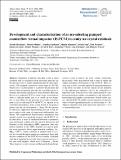Development and characterization of an ice-selecting pumped counterflow virtual impactor (IS-PCVI) to study ice crystal residuals
Author(s)
Hiranuma, Naruki; Möhler, Ottmar; Kulkarni, Gourihar; Schnaiter, Martin; Vogt, Steffen; Vochezer, Paul; Järvinen, Emma; Wagner, Robert; Bell, David M.; Wilson, Jacqueline; Zelenyuk, Alla; Cziczo, Daniel James; ... Show more Show less
DownloadCziczo_Development and characterization.pdf (1.806Mb)
PUBLISHER_CC
Publisher with Creative Commons License
Creative Commons Attribution
Terms of use
Metadata
Show full item recordAbstract
Separation of particles that play a role in cloud activation and ice nucleation from interstitial aerosols has become necessary to further understand aerosol-cloud interactions. The pumped counterflow virtual impactor (PCVI), which uses a vacuum pump to accelerate the particles and increase their momentum, provides an accessible option for dynamic and inertial separation of cloud elements. However, the use of a traditional PCVI to extract large cloud hydrometeors is difficult mainly due to its small cut-size diameters (< 5 µm). Here, for the first time we describe a development of an ice-selecting PCVI (IS-PCVI) to separate ice in controlled mixed-phase cloud system based on the particle inertia with the cut-off diameter ≥ 10 µm. We also present its laboratory application demonstrating the use of the impactor under a wide range of temperature and humidity conditions. The computational fluid dynamics simulations were initially carried out to guide the design of the IS-PCVI. After fabrication, a series of validation laboratory experiments were performed coupled with the Aerosol Interaction and Dynamics in the Atmosphere (AIDA) expansion cloud simulation chamber. In the AIDA chamber, test aerosol particles were exposed to the ice supersaturation conditions (i.e., RHice > 100 %), where a mixture of droplets and ice crystals was formed during the expansion experiment. In parallel, the flow conditions of the IS-PCVI were actively controlled, such that it separated ice crystals from a mixture of ice crystals and cloud droplets, which were of diameter ≥ 10 µm. These large ice crystals were passed through the heated evaporation section to remove the water content. Afterwards, the residuals were characterized with a suite of online and offline instruments downstream of the IS-PCVI. These results were used to assess the optimized operating parameters of the device in terms of (1) the critical cut-size diameter, (2) the transmission efficiency and (3) the counterflow-to-input flow ratio. Particle losses were characterized by comparing the residual number concentration to the rejected interstitial particle number concentration. Overall results suggest that the IS-PCVI enables inertial separation of particles with a volume-equivalent particle size in the range of ~ 10–30 µm in diameter with small inadvertent intrusion (~ 5 %) of unwanted particles.
Date issued
2016-08Department
Massachusetts Institute of Technology. Department of Earth, Atmospheric, and Planetary SciencesJournal
Atmospheric Measurement Techniques
Publisher
Copernicus GmbH
Citation
Hiranuma, Naruki et al. “Development and Characterization of an Ice-Selecting Pumped Counterflow Virtual Impactor (IS-PCVI) to Study Ice Crystal Residuals.” Atmospheric Measurement Techniques 9.8 (2016): 3817–3836.
Version: Final published version
ISSN
1867-8548